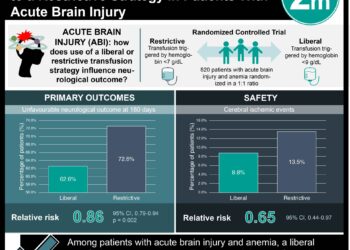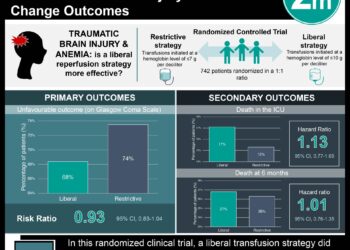MRI reveals evolution of cerebral microhemorrhages in traumatic brain injury
1. The number and volume of cerebral microhemorrhages (CMHs) due to traumatic brain injury (TBI) in military service members decreased over time, as shown by gradient recalled echo (GRE) and susceptibility weighted magnetic resonance (MR) imaging.
2. Quantitative susceptibility mapping (QSM) showed that the magnetic susceptibility of CMHs due to TBI decreases over time, revealing that hemosiderin in microhemorrhages undergo chronic evolution.
Evidence Rating: 3 (Average)
Study Rundown: TBI can lead to the development of CMHs as a direct result of the initial trauma and may cause clinically devastating consequences. Detection of CMHs is particularly important in deployed military personnel, of whom 10-20% are estimated to suffer from TBI. The current study identified CMHs in 43 patients out of a total of 603 military servicemen and women that had been clinically diagnosed with TBI. Of these patients, 13 underwent follow up MRI utilizing GRE and QSM, both of which highlight iron-containing blood products. A smaller number and decrease in the volume of microhemorrhages were identified in patients at follow-up imaging as compared to the initial MRI, based on QSMs at baseline and after follow up imaging. QSM also detected the temporal evolution of microhemorrhages, based on the change of magnetic susceptibility, suggesting that the hemosiderin products within the CMHs were evolving over time. This study revealed that CMHs are constantly remodeling over time rather than remaining stable with a constant degree of hemosiderin deposition after initial insult. This sets forth the prospect for further studies to determine the underlying mechanism of hemorrhage evolution in the brain as revealed by imaging features. Major limitations of this study included its relatively small size, particularly of the follow up imaging group, and the heterogeneity of the time to follow-up between patients. Future studies should aim to reproduce these findings in a larger cohort, and randomize observers of imaging chronicity to reduce bias.
Click to read the study in Radiology
Relevant reading: Cerebral microbleeds: a guide to detection and interpretation
In-Depth [retrospective cohort]: Patients were recruited between 2011 and 2013, and 43 of 603 patients (3.6% female; mean age 33.8 ± 8.0 years) with clinical diagnosis of TBI had CMHs identified on gradient-recalled-echo MR imaging and 3D flow compensated multi-echo gradient-recalled-echo MR imaging, with six excluded due to imaging artifacts. QSMs and susceptibility weighted images were derived for these patients, establishing baseline number, volume, and magnetic susceptibility for 37 patients. When compared to the results of 13 patients that had follow up imaging, there were fewer microhemorrhages (9.8 ± 12.8 vs. baseline of 13.7 ± 16.6; p = 0.019), each of which revealed an interval decrease in size (-0.85 ± 1.59 mm3/day; p = 0.039), and magnetic susceptibility (-0.10 ± 0.14 ppb/day, p = 0.016). The mean interval time since injury for patients with CMH was 885 ± 1161 days, and of those who underwent follow-up, the meal interval time since injury was 205 ± 226 days. The mean interval time between baseline imaging and follow-up imaging among the 13 patients with follow-up was 270 ± 144 days.
Image: CC/Flickr/Army Medicine/photo cropped
©2015 2 Minute Medicine, Inc. All rights reserved. No works may be reproduced without expressed written consent from 2 Minute Medicine, Inc. Inquire about licensing here. No article should be construed as medical advice and is not intended as such by the authors or by 2 Minute Medicine, Inc.







